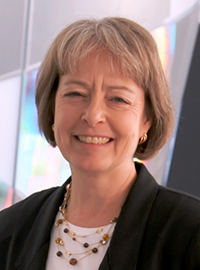
Judy M. Vance
Title(s):
Professor Emeritus
Mechanical Engineering
Information
Dr. Judy M. Vance is a professor emeritus of mechanical engineering and a former faculty fellow of the Virtual Reality Applications Center at Iowa State University. Dr. Vance is a Fellow of the American Society of Mechanical Engineers (ASME) and past chair of the ASME Design Engineering Division. She is a former Associate Editor of the ASME Journal of Mechanical Design and an NSF CAREER award recipient. She served as department chair of Mechanical Engineering at Iowa State University from 2003 to 2006 and she spent two years at the National Science Foundation (NSF) as the Program Director for Engineering Design and Innovation. She is a past member of the NSF Engineering Directorate Advisory Committee and served as co-chair of the NSF Committee of Visitors for the Design and Manufacturing Innovation Division. As co-chair, she led an 18 person team in preparing an evaluation of the procedures of the NSF DMI Division. In 2010 she was honored with the ASME Design Automation Award and in 2012 she received an Honorary Doctorate of Engineering degree from Heriot-Watt University, Edinburgh, UK.
Research Interests
Virtual reality applications in mechanical design, numerical methods that facilitate interactive design and spatial mechanism design.
News
2020-05-03 New ME scholarship named for longtime faculty member
2019-04-17 ME’s Judy Vance to retire at the end of the semester
2012-08-24 Vance receives honorary doctorate
2012-06-11 Iowa State’s METaL lab develops multiple ways to experience virtual reality
Education
- PhD, Mechanical Engineering, Iowa State University, 1992
- MS, Mechanical Engineering, Iowa State University, 1987
- BS, Mechanical Engineering, Iowa State University, 1980
Appointments
- Emeritus Professor of Mechanical Engineering, 2018-present
- Joseph C. and Elizabeth A. Anderlik Professor of Engineering, 2010-2018
- Professor, Department of Mechanical Engineering, Iowa State University, 2003-2018
- Program Director, Engineering Design and Innovation, National Science Foundation, 2006-08
- Chair, Department of Mechanical Engineering, Iowa State University, 2003-06
- Director of Graduate Education, Department of Mechanical Engineering, Iowa State University, 2002-03
- Associate Professor, Department of Mechanical Engineering, Iowa State University, 1997-2003
- Assistant Professor, Department of Mechanical Engineering, Iowa State University, 1992-97
- Assistant Professor, Division of Engineering Fundamentals and Multidisciplinary Design, Iowa State University, 1987-92
- Adjunct Instructor, Division of Engineering Fundamentals and Multidisciplinary Design, Iowa State University, 1984-87
Industrial and Other Non-Academic Experience
- Mechanical Engineer, John Deere Des Moines Works, Ankeny, IA, 1980-84
- Summer Intern, John Deere Des Moines Works, Ankeny, IA, 1979-80
- Co-Op Student, Maytag, Newton, IA, 1978